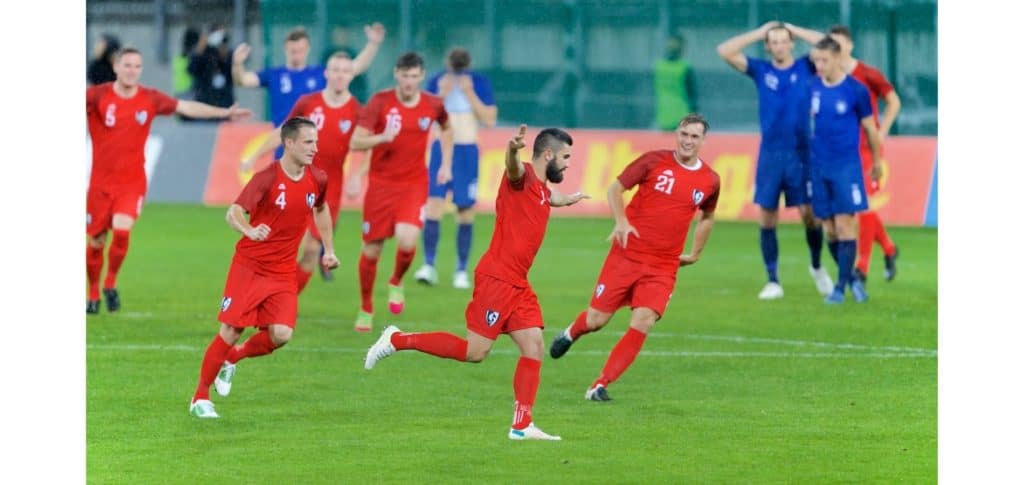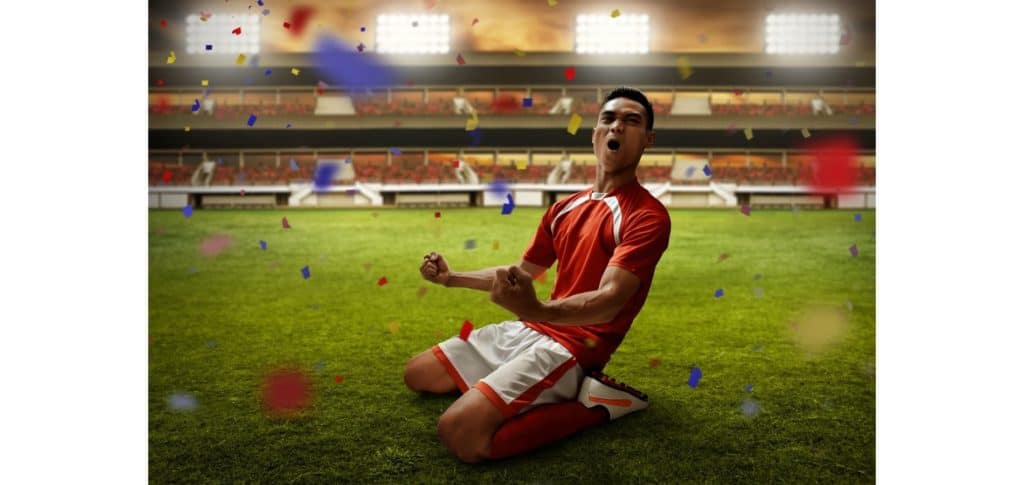Football is without doubt a home to some of the most iconic moments in sporting history.
After scoring a goal, the vast majority of professional players like to mark the event by performing a celebration that not only shows their happiness for themselves and their team mates, but also as a way of recognising and thanking the fans for their continued support.
One of the most common football commemorations that you’ll see – whether you’re inside the stadium or watching the game from home on the telly – is the famous knee slide.
A knee slide celebration is executed firstly by accelerating forward, before bending the knee of one leg in order to get closer to the ground and cushion the surface impact, and then tilting the upper body backwards to streamline the movement and reduce friction.
Then the motion nears its climax with the other leg used to perform the initial touchdown by way of the foot’s bridge. Once this leg comes in contact with the ground, the opposite leg then gently hits the grass, after which the actual sliding commences with speed maintained by reinforcing the backward positioning of the upper body.
Now that sequence can be a lot to take in for those unfamiliar with the complexities of celebratory techniques.
So, in the rest of the article I’ll document the process every step of the way.
However, before that I thought it would be important to talk about where the knee slide originated from.
Let’s begin…
Who started the knee slide celebration?
Manchester United fans will fondly remember when Ole Gunnar Solskjaer came off the bench to score the winner against German giants Bayern Munich in the 1999 Champions League final.
He capped his goal and cameo performance with a short yet incredibly passionate knee slide which – subject to official confirmation by football’s record keepers – appears to have been the first televised instance of the motion taking place.
It’s also quite fitting that the player who arguably cemented the knee slide celebration in the minds of fans across the globe, is in the conversation for being one of the greatest premier league forwards of all time.
For those of you with curiosity bubbles that are just about to burst, I’ll get to the point.
In the year 2002, former Arsenal player Thierry Henry marked his momentous goal in the North London Derby against fierce rivals Tottenham Hotspur with an iconic knee slide.
Take a look at this beauty of a goal!
Picking up the ball in his own half, the Frenchman dribbled past several Spurs players before calmly dispatching his shot past the helpless goalkeeper into the bottom corner of the net.
In fact, he was still so energised even after scoring as he wheeled off in celebration all the way past the half way line that he had originally come from, before finally delivering “the icing on the cake” with the exquisite knee slide motion.
Step by step process to execute a perfect knee slide
With the history behind the famous knee slide now covered, we can now look at exactly how the soccer players of today have managed to perfect it.
Let’s get started…
1. Build speed through forward movement

Due to the laws of physics, a knee slide will only work if the player in question has built up enough speed beforehand.
This is because once the lower body (i.e. legs and knees) come into contact with the ground, the friction that is generated by brushing the grass gradually slows the player down and they eventually come to a standstill.
Therefore, to prolong the slide, it is recommended that the player should attempt a short burst of speed over a distance of 15 to 20 metres prior to executing the slide, so that the motion can be prolonged and executed stylishly.
2. Bend the first knee
The landing phase then begins with the bending of the first knee.
It’s important to note here that the first knee shouldn’t actually touch the grass surface.
The logic behind this step is that bending one knee is a movement that brings the entire upper body closer to the ground, which ultimately leads to a more cushioned impact upon eventual landing.
If you want to avoid damaging parts of your lower legs or knees, then you mustn’t ignore this aspect of the knee slide process.
Ole Gunnar Solskjaer damaged his medial ligaments when celebrating his dramatic winner for Manchester United in the 1999 Champions League final clash against Bayern Munich.
Whilst he admitted that damage to his knee was done, he however dismissed claims that this particular injury led to his eventual retirement in 2007.
So, this specific player account really serves as a reminder of the importance of having the correct technique when performing a knee slide.
3. Tilt your body backwards

When it comes to pulling the upper body backwards, this step is necessary to reduce the amount of air resistance that the body encounters when it’s about to begin the motion.
This is important as air resistance can slow the players speed down, which would reduce the overall surface distance of the knee slide as the player in question would have less momentum pushing them through.
4. Connect with your foot bridge
Now this step is critical, so pay close attention.
Remember that the article said you should lower the first knee without touching the ground in the second step?
Well, at this juncture, the second leg should make first contact with the grass surface.
More precisely, the foot bridge leads the touchdown through flexion and extension at the ankle joint before the lower leg and knee can follow suit.
After the second leg has touched the ground, it becomes much easier for the player to safely land the initial bending leg on the surface, and it is from this point in the overall process that the sliding motion begins.
5. Double down on upper body backward positioning
With the sliding motion in full swing now, you will want to maintain your speed and ultimately prolong the action for as long as possible.
To do this, you will simply repeat the manoeuvre that was done in step 3, as bending the upper body even further back is an effective way of decreasing air resistance and streamlining the slide to perfection.
Think of it in a similar way to a Formula 1 car positioning itself in the slip stream of the vehicle in front of it. This is done to build up speed for an overtake, as by stationing themselves right behind the car in front they benefit from drag reduction and an increase in straight line speed.
Additional tips for knee sliding
Before I wrap up this piece, I just want to add a few pointers that will hopefully put you on your way towards perfecting the famous knee slide celebration.
Here goes…
Avoid jumping high beforehand
This is just a bit of common sense.
By jumping high before attempting a slide, you are increasing the risk of injuring your legs due to the added driving force of impact when you hit the ground.
You will notice that some professional players like to push their bodies forward by way of a jumping motion, but this is done in order to add to their sliding velocity.
So, be careful and avoid jumping upwards prior to performing a knee slide.
Land on your lower leg first
Despite the fact that players wear long football socks along with shin guards for added protection and cushioned impact, the knee area is still left exposed to damage.
So, you will want to make sure that you protect your knees by letting your lower legs make contact with the ground first before placing the knee on the surface and commencing the slide.
Ensure an unobstructed landing surface

Lastly, you will want to have a clear and unobstructed surface to slide on so that you can perform the movement smoothly and without fear of getting injured.
If there are any stones or pieces of equipment strewn on the field, you are likely to pick up a knee injury resulting from the strong contact made when hitting such items.
Closing thoughts
So, there you have it!
Footballers perform the action of sliding on their knees when celebrating a goal that they scored. They will execute this move first through accelerating by way of running forward, then by bending the first knee, after which they will tilt their upper body backwards and finally landing on the opposite lower leg and subsequent knee.
I hope this article was useful to all that read it.
Should you be interested in reading a similar topic, then check out our recently published article on why soccer players take the knee before the start of matches.
If you enjoy the content that I create and would like to buy me a coffee, then I’d really appreciate it!
Any money that I earn through this donation will be re-invested into more content for this website.
Additionally, by sending in a donation you’ll also receive a copy of my recently released 190+ page eBook on Soccer Ball Care, as well as be subscribed to our mailing list where you’ll be regularly informed on the latest developments concerning the Soccer Whizz blog.
- Future Icons: Europe’s Emerging Midfield Maestros Set for Glory - December 4, 2023
- Kickstarting a Revolution: How Soccer Transformed the United States Over the Last Four Years - October 7, 2023
- 4-1-4-1 Soccer Formation [Analysis] - September 23, 2023

